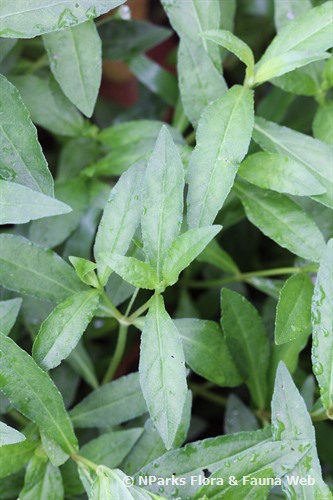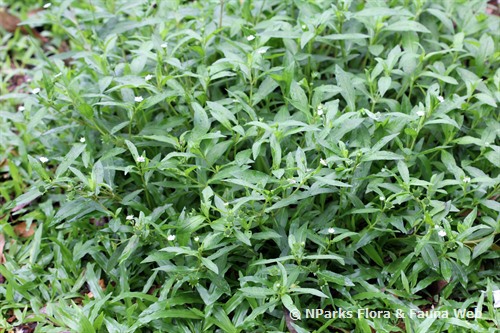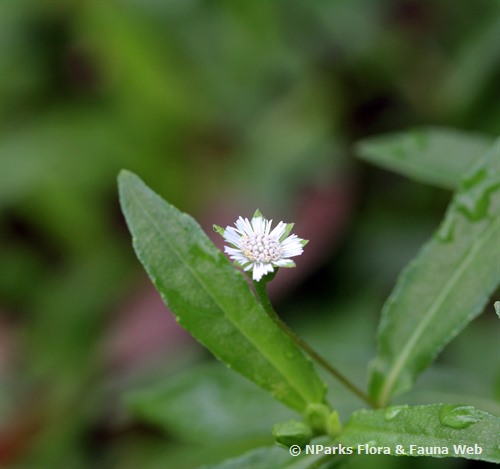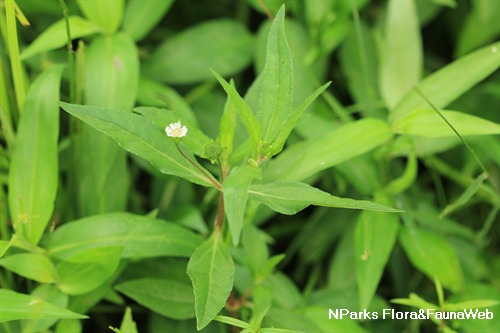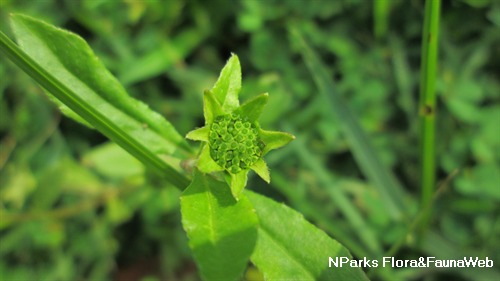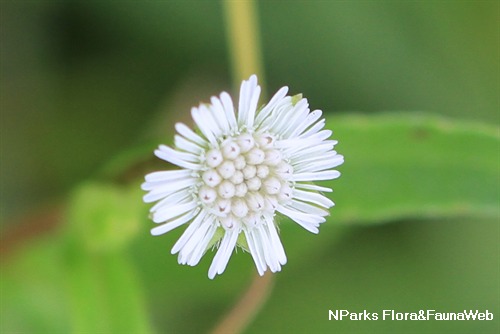
Back
Eclipta prostrata (L.) L.
| Family Name: | Asteraceae (Compositae) |
| Synonyms: | Acmella lanceolata Link ex Spreng. |
| Common Name: | White Heads, Aring-Aring, False Daisy, 鳢肠 |
Name
Classifications and Characteristics
| Plant Division | Angiosperms (Flowering Seed Plants) (Dicotyledon) |
|---|---|
| Plant Growth Form | Herbaceous Plant |
| Lifespan (in Singapore) | Perennial |
| Mode of Nutrition | Autotrophic |
| Maximum Height | 0.3 m |
Biogeography
| Native Distribution | Sub-Saharan Africa |
|---|---|
| Native Habitat | Terrestrial |
| Local Conservation Status | Non-native (Spontaneous (Naturalised)) |
Description and Ethnobotany
| Growth Form | Annual herb up to 60 cm tall with erect or horizontal stems. |
|---|---|
| Foliage | Lance-shaped, papery leaves (3-10 x 0.5-2.5 cm) either lack leaf stalks or have short ones. The upper and lower leaf surface is densely covered in stiff or soft hairs. |
| Stems | Green or reddish purple stem is round and usually covered in white hairs. |
| Flowers | Florets are arranged in a compound head that resembles a tiny daisy (6 mm wide) with white, petal-like ray florets surrounded by green disc florets. They are located in the leaf axils (the space between the leaf and adjacent portion of stem) either singly or in small clusters. |
| Fruit | Small, black fruits (3 mm long) are known as achenes. Each fruit has 2 short horns known as pappus. |
| Habitat | Occurs near roadsides, rivers, and ponds, as well as lowland/ upland fields and disturbed habitats. Able to tolerate waterlogged and saline soils. Common weed among crops in Indonesia, Philippines and India, especially rice paddies. |
| Cultivation | Plants require damp to wet soil under full sun or semi-shade. They are fast-growing plants, therefore able to produce numerous seeds that germinates easily. |
| Etymology | The genus Eclipta means deficient, which refers to few receptacular scales. The specific epithet prostrata means lying flat but not rooting, prostrate growth habit. |
| Ethnobotanical Uses | Medicinal: Aqueous extract contains strong antioxidant activity. It absorbs uva and uvb irradiation, protecting cells from harm. |
Landscaping Features
| Desirable Plant Features | Ornamental Flowers |
|---|---|
| Landscape Uses | Small Gardens, Pond / Lake / River, Marsh / Bog |
Plant Care and Propagation
| Light Preference | Full Sun, Semi-Shade |
|---|---|
| Water Preference | Lots of Water, Moderate Water |
| Plant Growth Rate | Fast |
| Rootzone Tolerance | Moist Soils, Waterlogged Soils |
| Transplanting Tolerance | Moderate |
| Potential Problems | To serious pest and disease problems. |
| Propagation Method | Seed |
Foliar
| Foliage Retention | Evergreen |
|---|---|
| Mature Foliage Colour(s) | Green |
| Mature Foliage Texture(s) | Hairy / Hirsute, Papery |
| Prominent Young Flush Colour(s) | Green |
| Young Flush Texture(s) | Hairy / Hirsute, Papery |
| Foliar Type | Simple / Unifoliate |
| Foliar Arrangement Along Stem | Opposite |
| Foliar Attachment to Stem | Petiolate, Sessile |
| Foliar Shape(s) | Non-Palm Foliage (Lanceolate) |
| Foliar Venation | Pinnate / Net |
| Foliar Margin | Entire, Serrulate |
| Foliar Apex - Tip | Acute |
| Foliar Base | Attenuate |
Floral (Angiosperm)
| Flower & Plant Sexuality | Unisexual & Bisexual Flowers(Sub-dioecious) |
| Flower Colour(s) | White |
|---|---|
| Flower Texture(s) | Smooth |
| Flower Grouping | Cluster / Inflorescence |
| Flower Location | Axillary |
| Flower Symmetry | Asymmetrical |
| Individual Flower Shape | Tubular |
| Inflorescence Type | Compound Head / Capitulum |
| Flowering Period | Free-Flowering |
| Flower Lifespan on Plant | Several Days |
| Inflorescence Size | 6 mm |
Image Repository
Others
| Master ID | 31271 |
|---|---|
| Species ID | 5667 |
| Flora Disclaimer | The information in this website has been compiled from reliable sources, such as reference works on medicinal plants. It is not a substitute for medical advice or treatment and NParks does not purport to provide any medical advice. Readers should always consult his/her physician before using or consuming a plant for medicinal purposes. |

